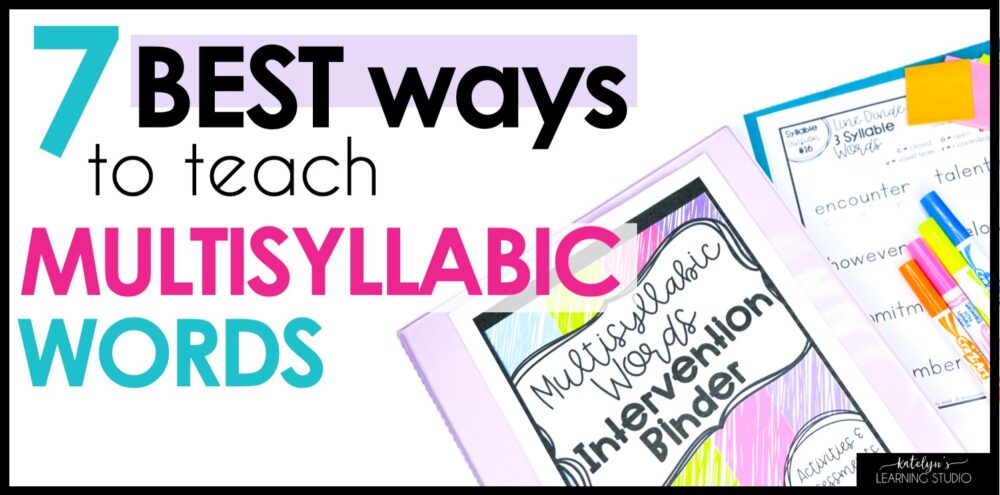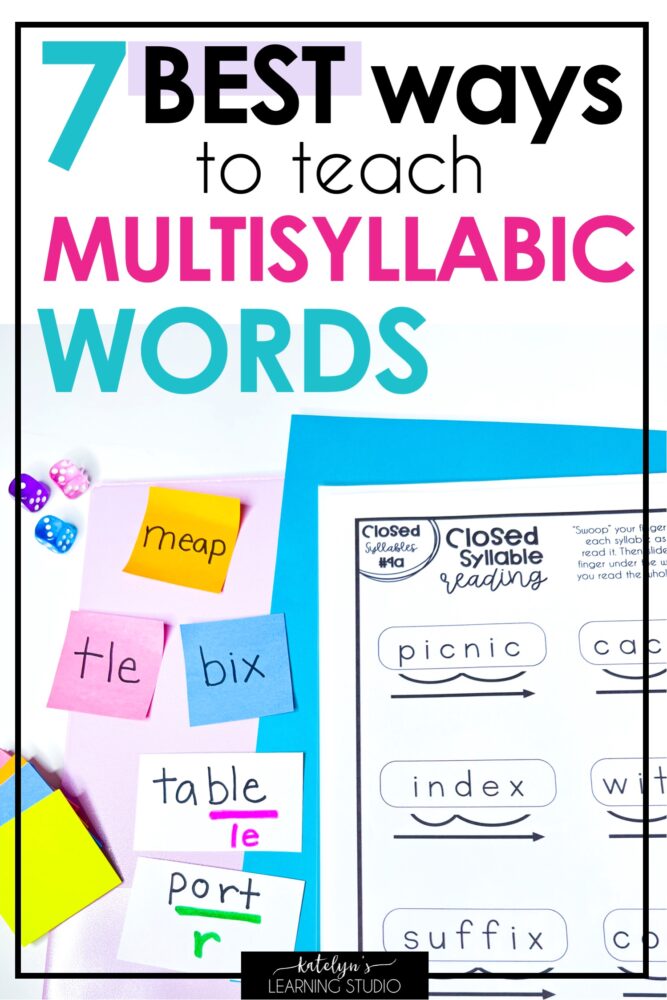7 Best Ways to Teach Multi-Syllabic Words to Struggling Readers
Looking to help your struggling readers make the jump to reading multi-syllabic words? Here are the 7 best strategies and activities for how to teach kids multisyllabic words without getting overwhelmed!
It is SO exciting when blending simple cvc words starts to click for students. Once they learn how to use phonics to decode words, they make rapid progress and you’re thinking:
“Great! We made it! We got this in the bag!”
But then… progress plateaus!
Their reading level seems stuck at those simple level words and they just can’t make the jump up to grade level.
You know what it probably is?
Struggling readers often cannot seem to get past those daunting mutli syllabic words.
They see them, their heart rate starts to rise, and then they freeze.
Sound familiar?
It can be so hard as a teacher to watch all of their hard work and progress not be enough to get them caught up.
But…
Do not give up!
How do you teach kids multisyllabic words?
Here are some simple (but effective!) strategies and activities you can do to help your students close that gap into reading multi-syllabic words.
🎬👇 {Psst: here’s a video showing all of the activities in action!}
Those kids are often so much closer than they realize to reading those big words. They just need to build their confidence and put some tools in their tool belt for what to do when they see those scary words!
*Heads-up, you’ll definitely want to grab this FREE Reading Intervention Cheat Sheet for more tips and activity ideas to help your struggling readers, plus find identifying characteristics to help you pinpoint exactly which areas of reading your students need help in!
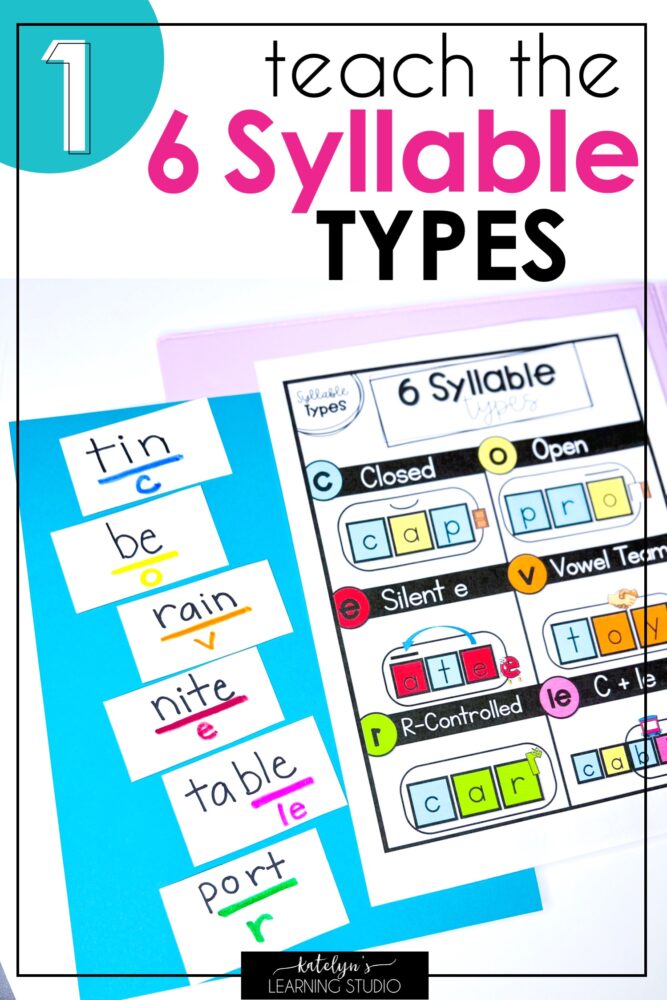
Teach the 6 syllable types to help equip students with the tools they need to read multi-syllabic words. (pictured: Multisyllabic Words Intervention Binder)
1. Teach the 6 Syllable Types
One way to help your kiddos tackle these longer multi-syllabic words is by teaching them the 6 syllable types.
Most syllables fall into one of these 6 types of syllables:
- Closed Syllables: end in a consonant and have a short vowel sound
- Closed syllable examples: “cat” and “box”
- Open Syllables: end in a vowel and have a long vowel sound
- Open syllable examples: “So” and “by”
- Silent e Syllables: ends in a vowel, but the final e is silent, and the preceding vowel sound is long
- Silent e syllable examples: “cake” and “hope”
- Vowel Team Syllables: contain two or more vowels that work together to make one sound
- Vowel team syllable examples: “team” and “boat”
- R-Controlled Syllables: have a vowel sound that is changed by the letter r
- Vowel team syllable examples: in “car” and “port”
- Consonant + le Syllables: end in an “-le” and have a consonant right before the “-le”
- Consonant + le syllable examples: the “-ble” in “table” and the “-tle” in “bottle”
When children encounter words with multiple syllables, it can be overwhelming and challenging to read them. However, understanding the different syllable types and their patterns can make decoding multisyllabic words much easier.
By teaching kids the six syllable types, they will have a better understanding of how to break down and read longer words.
**You will want to start by having them read single syllables for each syllable type first, to make sure they master their phonics skills before trying to apply it to multi-syllabic words. Then when they move on to reading multi-syllabic words, they will be able to pick out and read each syllable type much easier!
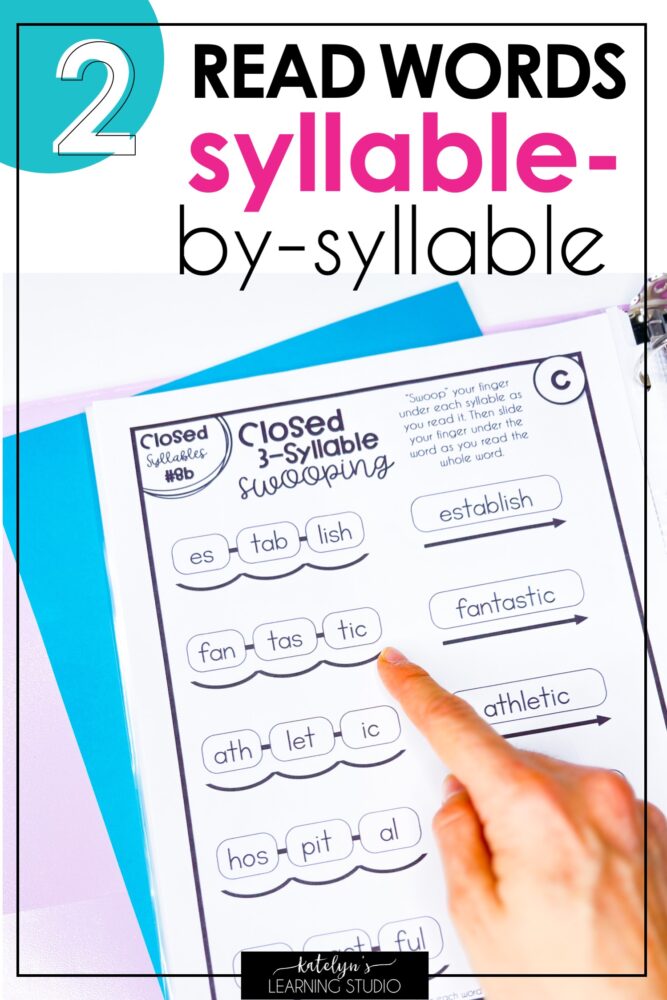
Decode multisyllabic words syllable by syllable to avoid overwhelm. (pictured: Multisyllabic Words Intervention Binder)
2. Read Multi-Syllabic Words Syllable by Syllable
Once students have a solid foundation in the 6 syllable types, the next step is to put those syllables together to read multi-syllabic words!
The easiest way to jump into decoding multisyllabic words is to break it down syllable by syllable. Students already know how to read each syllable, now they just need to read them in order and put them together!
How to Read Words Syllable by Syllable:
- Display syllables separately in order, then the whole word next to them.
- Have students read the syllables individually, in order.
- Then have them read the whole word.
- Optional: add “swooping lines” under each syllable to encourage fluency in blending, and an arrow under the whole word to promote smoothly reading the whole word. These also add a tactile, multi-sensory element which is crucial for struggling readers! (see my Ultimate List of Reading Intervention Activities for more multisensory ideas!)
Here are some activity ideas for reading words syllable by syllable:
- Write each syllable spaced out on a paper and then have the whole word written together next to them.
- Write each syllable on a note card or sticky note and hang them on a whiteboard. Then write the whole word next to the syllables.
- Show each syllable separated by a box to draw focus to the individual syllables (prevents overwhelm!) and show the word next to it, like I do in my Multisyllabic Words Intervention Binder.
- As students progress, you can show the whole word and have “swooping lines” under each syllable in the whole word.
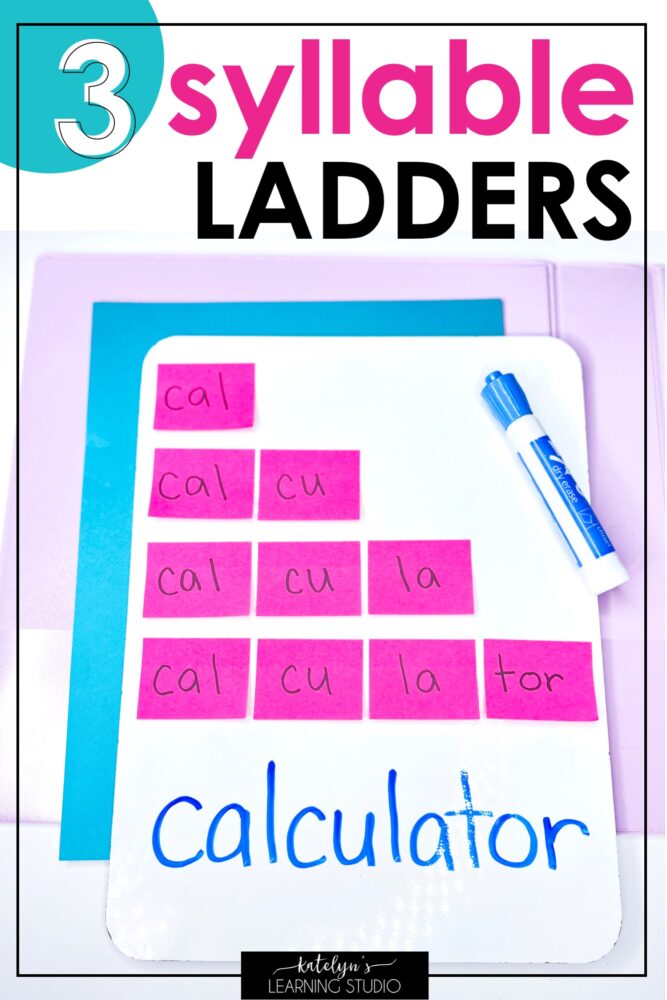
Using decoding strategies like syllable ladders can help make reading multi-syllabic words easier for struggling readers.
3. Multi-Syllabic Word Ladders
Word ladders are another fun version of reading multi syllabic words syllable by syllable, like above.
This activity involves creating a ladder of syllables, with each rung of the ladder representing a different syllable. Students can then use these ladders to practice reading and spelling multi-syllabic words.
For example, the ladder for the word “calculator” would look like this:
cal
cal cu
cal cu la
cal cu la tor
calculator
This is a great way to prevent that common overwhelm and anxiety that comes with big words. Just presenting one syllable at a time helps students take it step by step without getting overwhelmed.
This is a great activity for building confidence in reading multi syllabic words!
It is so fun to see them realize that they already know and can read each syllable separately–and then see their pride when they can put them all together and read that final word with confidence!
Ideas for Implementing Word Ladders:
- Write the parts of the word ladder written out on a piece of paper.
- Write the syllables on index cards cut into small pieces, then write the whole word on a whole index card.
- Use small sticky notes for each syllable and stick them in a pyramid shape, with the whole word on an index card at the bottom.
If you want some syllable ladders already made for you, these Syllable Ladder Cards & Worksheets are so convenient and SO effective!
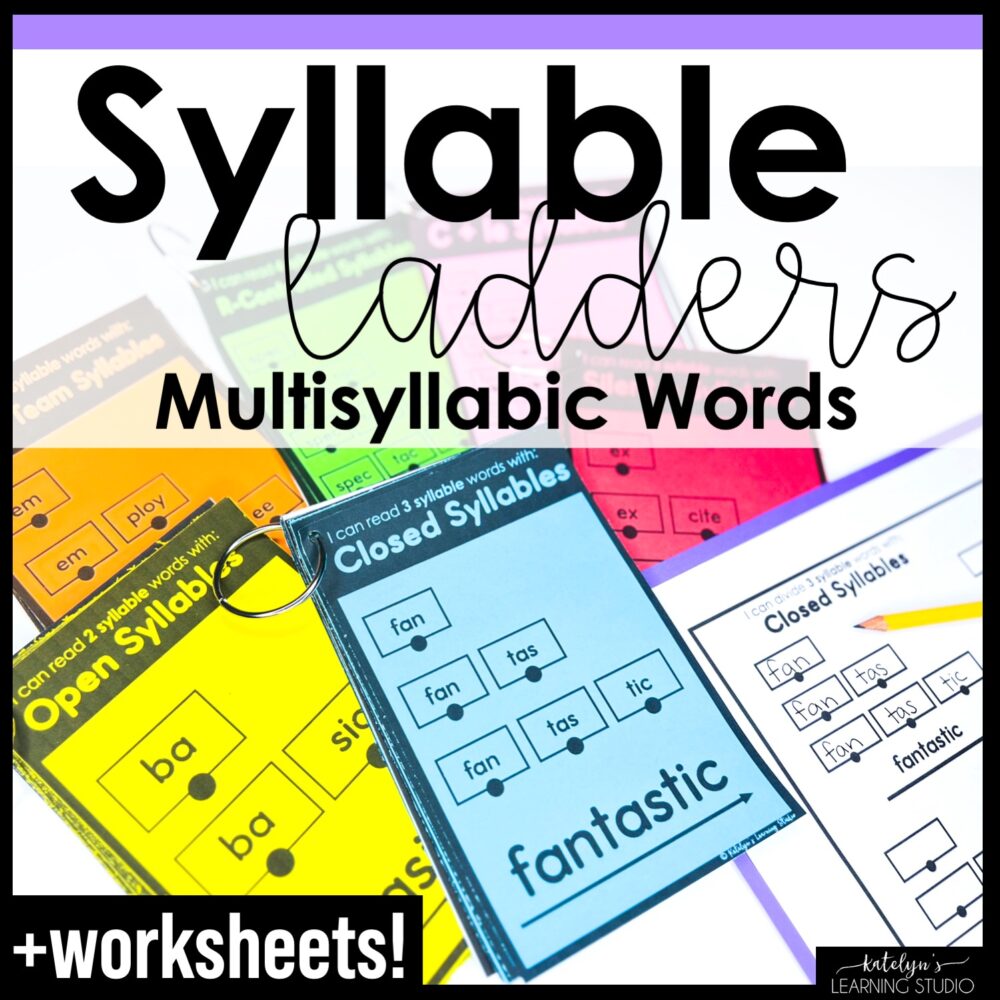
Practice reading multiple-syllable words with these awesome word ladder cards!
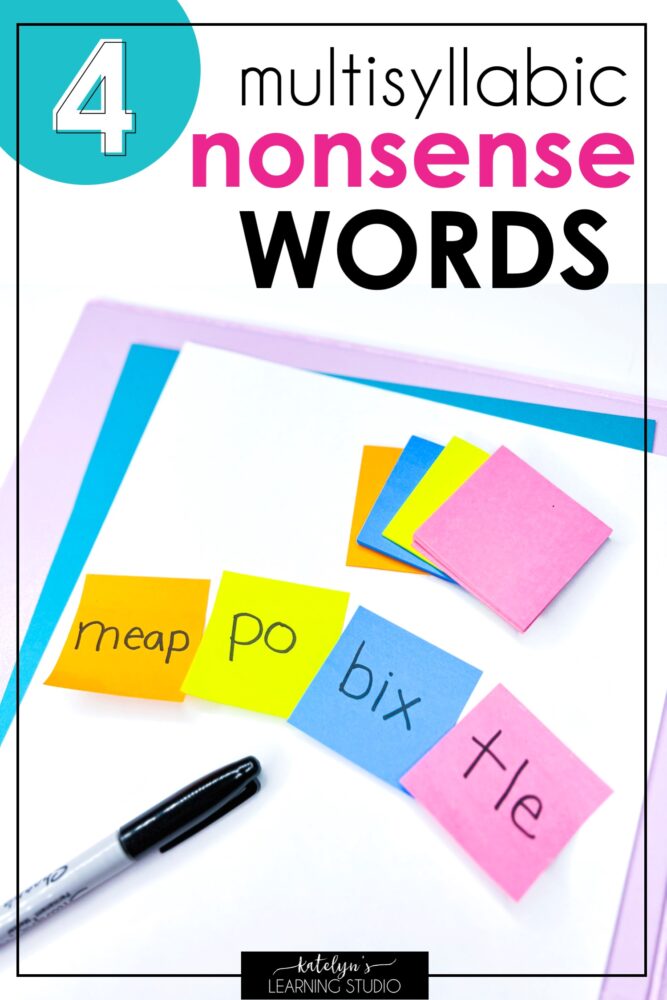
Nonsense multisyllabic words are a fun and effective way to make sure students master syllable reading skills.
4. Multisyllabic Nonsense Words
Reading made-up nonsense words may seem counterintuitive, but stick with me on this one and give it a chance!
What are nonsense words?
Nonsense words are made-up words that follow the rules of language, but don’t have any actual meaning.
It might sound silly, but it really works!
Start with 1-syllable nonsense words for each of the six syllable types, and gradually move on to 2 and 3-syllable words.
- One-Syllable nonsense words
- To start, you’ll want to focus on nonsense words with 1-syllable for each of the six syllable types (closed, open, silent e, vowel team, r-controlled, and consonant + le)
- Examples:
- a closed syllable nonsense word could be “bix”
- an open syllable nonsense word could be “po”
- Multisyllabic Nonsense Words
- Once they can easily read 1 syllable nonsense words, you’ll want to introduce multisyllabic nonsense words.
- Have your kiddos sound out each syllable according to the 6 syllable types they just learned, and then blend them together to read a multisyllabic nonsense word.
- Examples:
- a two-syllable word with closed syllables could be “bixlet”
- a three-syllable word with closed and r-controlled syllables could be “mivtenor”
Keep encouraging them to sound out each syllable and blend them together to read the whole word.
Reading nonsense words can seem weird, but it’s a super helpful way for children to practice decoding unfamiliar words and really solidify their phonics skills.
Think about it… when they encounter really large, unfamiliar academic words in college textbooks–those are basically nonsense words to them! They do not know what they mean yet, and will have to sound those words out chunk by chunk.
Practicing nonsense words prepares them for how to tackle longer words that they have never seen before and helps them read multi-syllabic words with confidence!
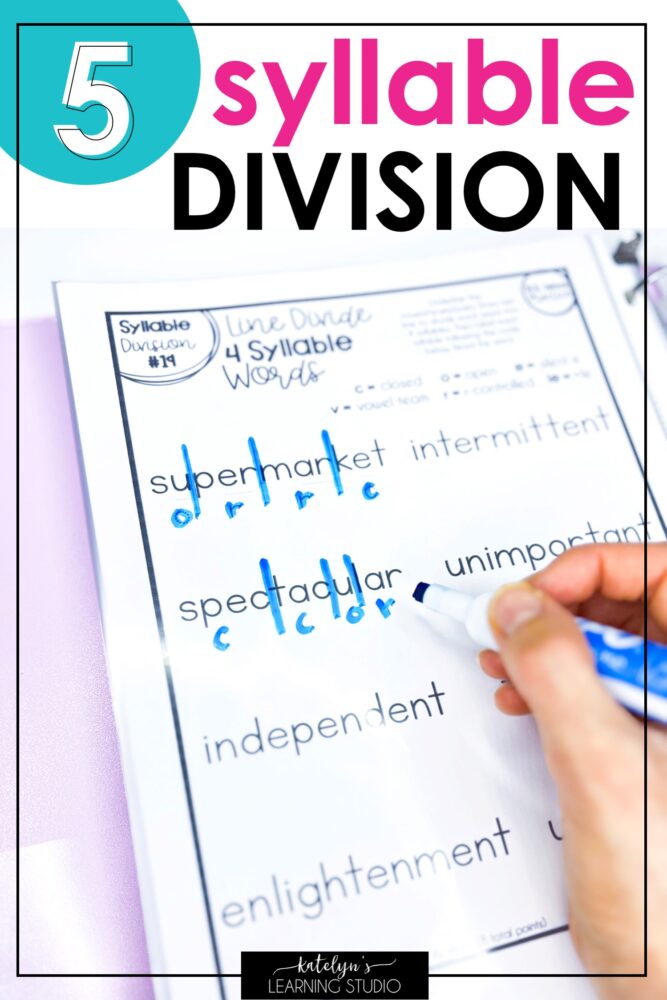
Syllable division is a great skill for students to practice identifying syllables they already know how to read. (pictured: Multisyllabic Words Intervention Binder)
5. Syllable Division for Multi-Syllabic Words
Once students are confident in reading individual syllables and putting them together, the next step is to go the opposite direction– start with the whole word and break it into syllables.
We call this syllable division.
Syllable division gives students a tool to use when they see a new multi-syllabic word. They start fresh with the whole word and it teaches them how to break it down into easier-to-read syllables.
To teach syllable division, you’ll want to follow the following process.
Syllable Division Process:
- Teach students that there is only one vowel sound for each syllable.
- Practice ORALLY counting the syllables you hear in words.
- Only out loud–just listen to a word and say or count the syllables you hear.
- One trick for teaching this is to have students hold their hand under their chin. Say the word slowly, and each time their chin goes down and hits their hand, that is a syllable.
- Go on a “syllable search” by circling certain syllable types in written words.
- Draw lines to divide written words into syllables
- After dividing the word into syllables, label each syllable!
Here’s an easy key for labeling syllables:
c = closed o = open e = silent e v = vowel team r = r-controlled vowels le= consonant + le
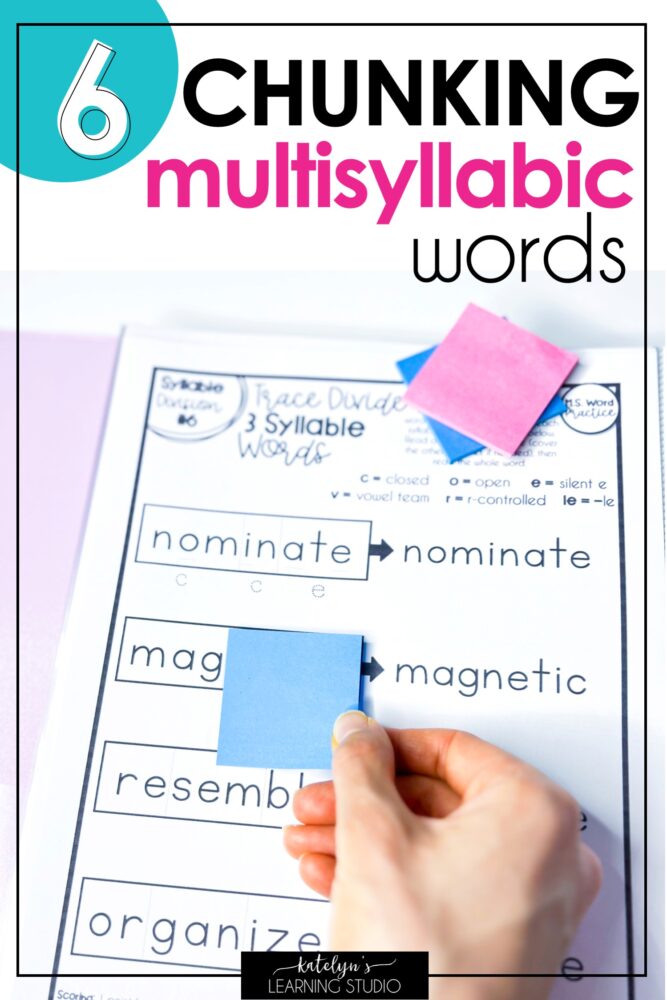
Use chunking when decoding multisyllabic words to break words into easier-to-read parts. (pictured: Multisyllabic Words Intervention Binder)
6. Chunking Multi-Syllabic Words
Chunking is a more informal strategy that students can use while they are reading multi syllabic words in real-life contexts (aka: while they are reading books that they cannot mark up).
- When students come across a big word they don’t recognize, have them use a notecard (or their hand!) to physically cover up all of the word except the first “chunk” of the word.
- Then slowly uncover one chunk at a time to read until they read the whole word.
This is a great way to avoid that deer in a headlight “freeze” when they come across new, big words. And they always have their hand with them, so they can use it at any time!
I talk more about this strategy in my 13 Phonics Strategies You Need to Try blog post, along with some other VERY essential phonics tips.
Also, these Multisyllabic Chunking Cards are perfect for some no-prep practice chunking big words!
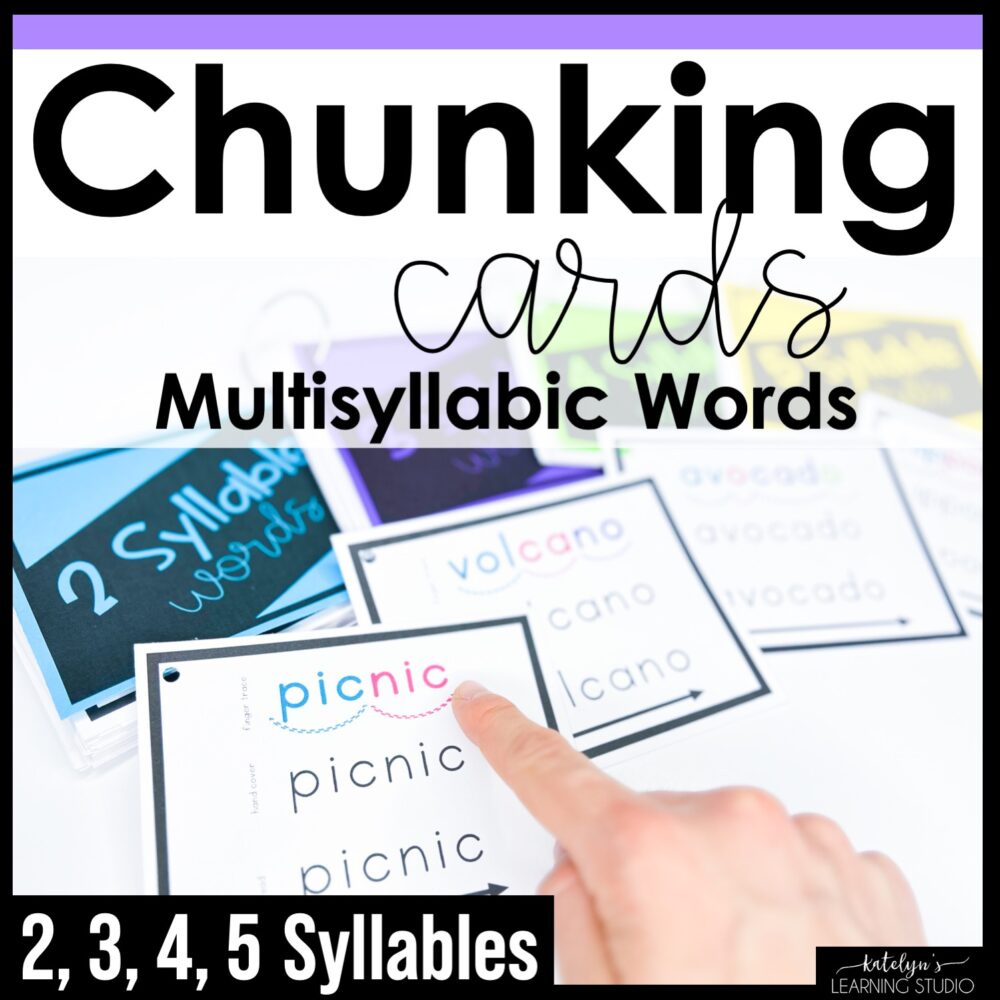
These chunking cards are excellent for practicing reading multi syllabic words by syllable division!
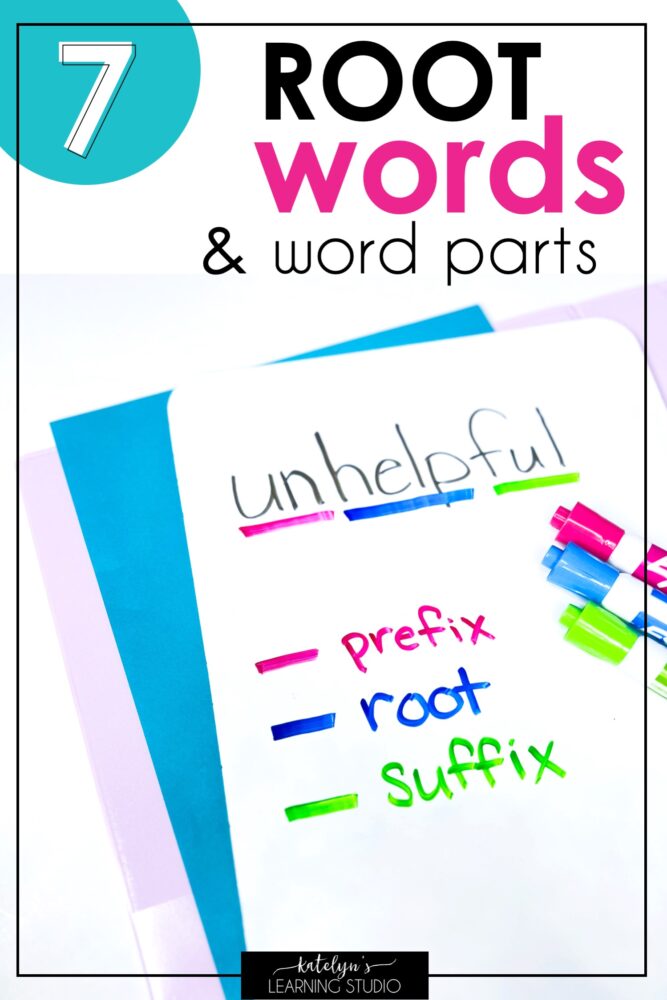
Using root words decoding strategies help build decoding and vocabulary skills.
7. Root Words and Word Parts in Multi Syllabic Words
The last strategy for reading multi syllabic words is to teach students root words and word parts.
They call this strategy the “word analysis” approach as opposed to the “syllable division” approach. It is a little more advanced but is a great strategy to use as students start recognizing familiar word parts and the meaning of various common root words.
Here is my suggested teaching method for word parts and root words.
How to Teach Root Words and Word Parts:
- Suffixes: Start with simple word endings! Teach the word ending, then have them read easier words they know with the new ending added on.
- Prefixes: Use the same process as above. Teach the prefix, and then add it to the base words they already know.
- At this point you can also practice words with both prefixes and suffixes!
- Latin and Greek Root Words: Last, teach common Latin and Greek root words and their meanings.
- There are so many “hidden” root words in common words! Learning to recognize the roots will make it so much easier to quickly pick them out in multi-syllabic words.
*Side note: learning the MEANING behind root words (or any word part!) is super important for these 2 reasons:
- It helps boost vocabulary as they will be able to figure out the meaning of words by their word parts (here is a blog post with 7 Helpful Vocabulary Strategies if you want some more vocab ideas!)
- It also helps with orthographic mapping! One of the steps to orthographic mapping is learning the meaning of the word–it will help them remember and turn that word into a sight word so much faster! (wondering “what is orthographic mapping?” This blog post explains it in simple terms!)
Multi-Syllabic Words Reading Intervention
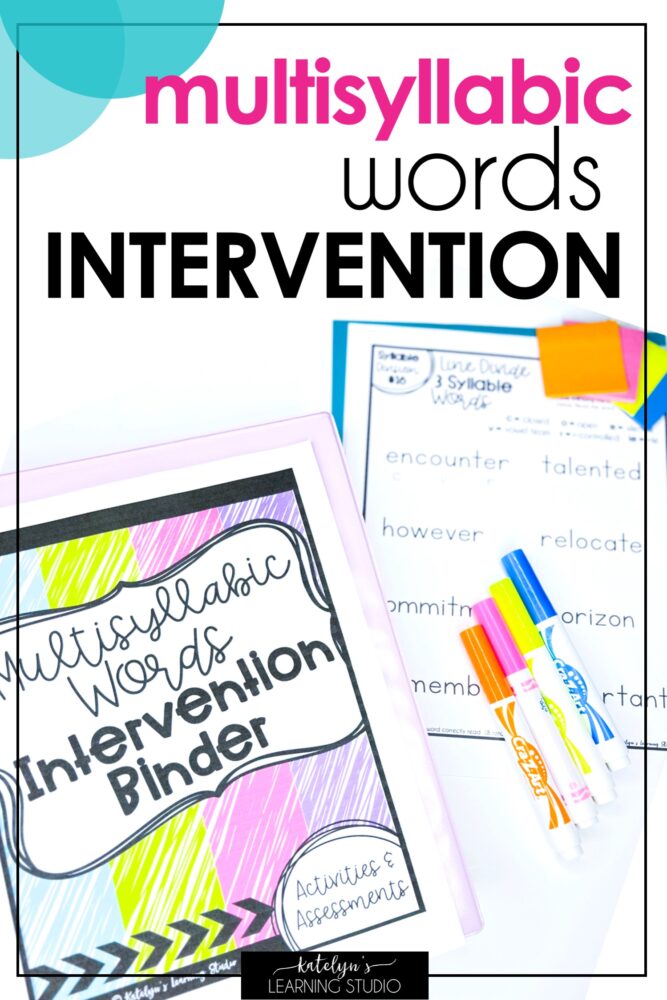
To make multi-syllabic word reading intervention a breeze, check out this no-prep intervention binder!
If you have students who are struggling to read multi syllabic words, this intervention binder will help so much! Not only does it break decoding multisyllabic words down into easy-to-master baby steps (great for building confidence!) but it makes planning lessons and activities that you KNOW will work so much easier!
👉 You can check it out by clicking here: Multisyllabic Words Intervention Binder
⭐ To see reading activities in action, check out my YouTube page (@katelynslearningstudio), and subscribe if you find the videos helpful!
⭐ To find done-for-you reading resources, visit my TPT Store (Katelyn’s Learning Studio)!
There you have it! My top 7 ways for how to teach multisyllabic words to new or struggling readers. All of these activities focus on building a strong phonics foundation (remember those 6 syllable types!), and tackling multi syllabic words one little syllable a time. This is SO much less intimidating for your readers, and you will have SO much fun watching their confidence soar as they decode multi syllabic words without the anxiety!
